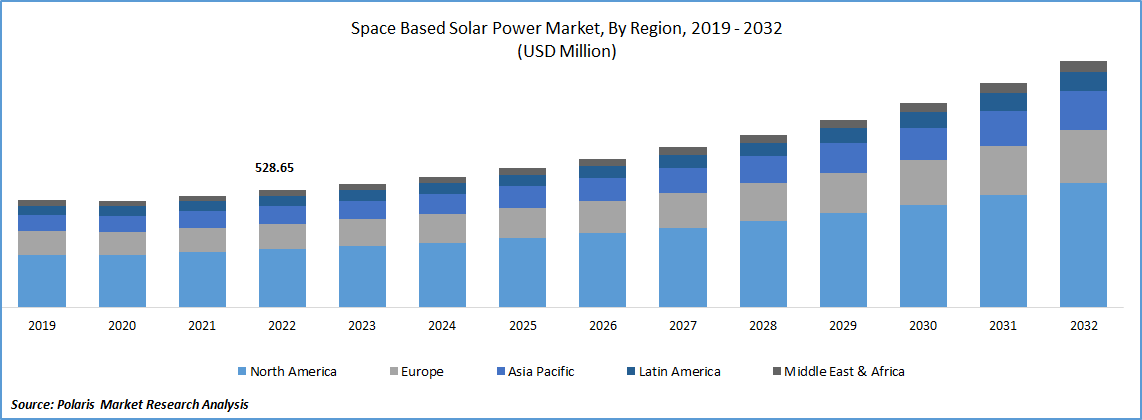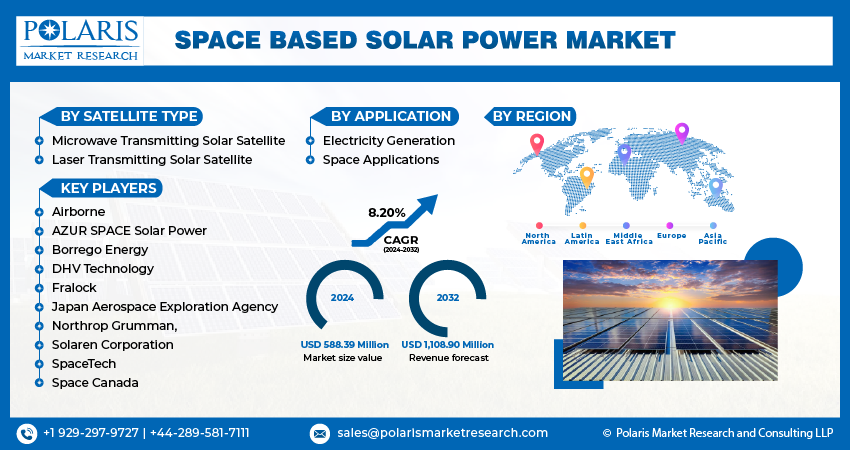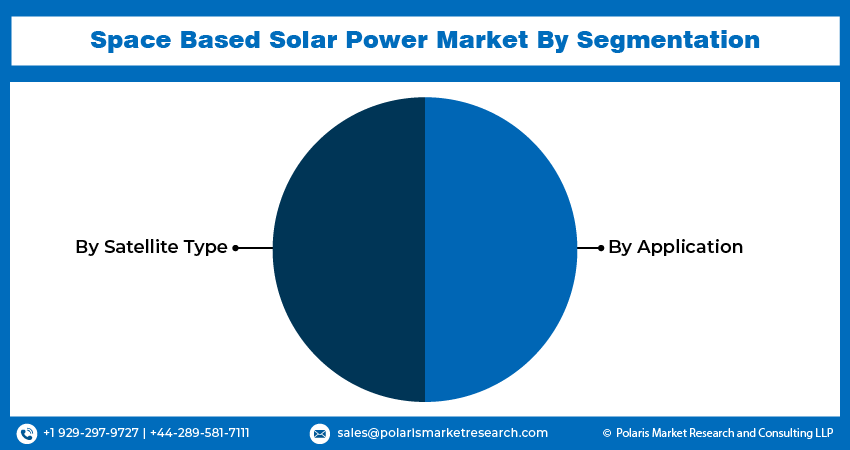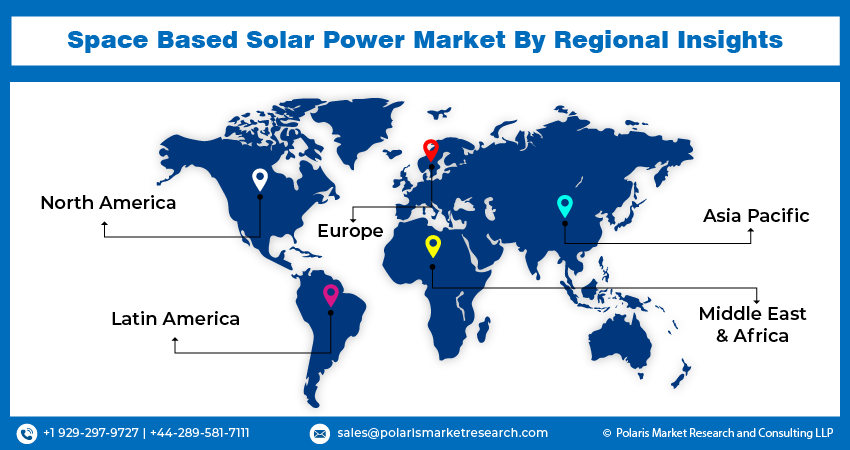
Space Based Solar Power Market Share, Size, Trends, Industry Analysis Report, By Satellite Type (Microwave Transmitting Solar Satellite, Laser Transmitting Solar Satellite), By Application, By Region, And Segment Forecasts, 2024 - 2032
- Published Date:Jan-2024
- Pages: 118
- Format: PDF
- Report ID: PM3787
- Base Year: 2023
- Historical Data: 2019-2022
Report Outlook
The global space based solar power market was valued at USD 555.08 million in 2023 and is expected to grow at a CAGR of 8.20% during the forecast period.
Space-based solar power (SBSP) is a revolutionary concept that harnesses solar energy in space using solar power satellites and then transmitting it to receiving stations on Earth. The process involves capturing solar energy beyond the Earth's atmosphere, where sunlight is much stronger and available 24/7, without the interference of weather conditions. The energy collected in space is then beamed back to Earth in the form of microwaves or laser beams, which are converted into electricity at receiving stations on the ground.

To Understand More About this Research: Request a Free Sample Report
Automation plays a vital role in optimizing operations, and enhancing reliability, and has the potential to reduce the overall costs of space-based solar power systems. These advancements in space technology, combined with the increasing demand for sustainable and clean energy solutions, are fueling significant interest and driving the potential expansion of the market. With a growing global emphasis on sustainable technologies, space-based solar power systems present an appealing option to meet energy demands while simultaneously reducing dependence on fossil fuels and mitigating environmental impacts.
SBSP has the potential to address some of the significant challenges faced by space missions and infrastructure. One of the primary applications of SBSP is in powering space vehicles, satellites, & rovers. By tapping into abundant solar energy from space, such systems can operate for extended periods without the need for frequent refueling or reliance on limited energy sources.
Moreover, SBSP can provide a continuous and reliable power source for space missions, especially for missions in deep space or those requiring long-duration stays in space. For example, future missions to the Moon or Mars could benefit from SBSP to ensure a stable energy supply, reducing the need for resupply missions and making space exploration more sustainable and cost-effective. In addition to space applications, the energy collected through SBSP can be transmitted back to Earth to provide electricity for various purposes. The receiving stations on Earth can convert the transmitted energy into usable electricity to power homes, businesses, and even entire cities. This has the potential to transform how we generate and distribute electricity, reducing our dependence on fossil fuels and mitigating the impact of climate change.

Industry Dynamics
Growth Drivers
Utilization of Robotics and Automation in Space Missions
The utilization of robotics and automation in space missions has played a pivotal role in cutting costs and enhancing operational efficiency. Robotic systems can carry out maintenance and repair tasks on space-based infrastructure, reducing the need for human intervention and the associated expenses. The ability of robots to perform intricate tasks in the harsh and challenging space environment allows for better maintenance and prolonged operation of space-based solar power systems.
The combination of reusable rockets and robotic automation has revolutionized space technology and expanded the possibilities for sustainable and cost-effective space exploration and utilization. This progress brings us closer to realizing the potential of space-based solar power and other ambitious ventures in space, making space-based energy solutions and space missions more economically viable and sustainable.
Report Segmentation
The market is primarily segmented based on satellite type, application, and region.
|
By Satellite Type |
By Application |
By Region |
|
|
|
To Understand the Scope of this Report: Speak to Analyst
By Application Analysis
Electricity Generation Segment Accounted for the Largest Share in 2022
Electricity generation accounted for a major global share. This significant share is attributed to the increasing energy demand across various industry verticals and the growing preference for cleaner electricity generation methods. By tapping into this virtually unlimited and constant solar energy source, continuous electricity generation becomes possible, ensuring a steady and reliable power supply.
Moreover, space-based solar power systems play a crucial role in supplying power to spacecraft and satellites, eliminating the need for frequent refueling or reliance on limited onboard energy storage. This enables longer missions, & enhanced functionality for these technologies, further advancing space exploration and satellite operations. With these benefits, these systems present a transformative solution for meeting energy demands and empowering space-based endeavors.
The space segment is likely to register the highest growth rate. It offers a continuous and dependable power source for satellites operating in space. Satellites rely on electricity to support their communication, navigation, data collection, and scientific instruments, among other functions. With these SBSP systems, these satellites can enjoy an uninterrupted power supply, reducing their dependence on onboard batteries.
Additionally, space-based solar power plays a crucial role in powering various space infrastructures, such as space habitats, stations, and research facilities. These structures require a reliable and constant energy source to facilitate communication, support life systems, conduct experiments, and perform various activities in the space environment. Space-based solar power systems offer the necessary power to sustain and support these critical space processes.
By Satellite Type Analysis
Microwave Transmitting Solar Satellite Segment Expected to Hold the Largest Share in 2022
Microwave transmitting solar satellite segment is projected to hold a significant market share. With the increasing global demand for renewable energy, many countries are exploring new power sources beyond Earth, and microwave-transmitting solar satellites present a promising and innovative solution to meet this growing need. By harnessing solar energy in space and beaming it back to Earth in the form of microwaves, these satellites offer an attractive option for sustainable and clean energy generation, making significant strides towards a greener and more sustainable future.
Laser segment witnessed steady growth. These satellites can be utilized to supply power to the orbital transfer vehicles for their missions. By beaming power from space, these satellites assist in meeting the energy requirements of these vehicles, reducing their reliance on onboard energy sources. This advancement enhances the capabilities and endurance of orbital transfer vehicles, enabling them to perform their tasks more effectively and efficiently.

Regional Insights
North America Region Dominated the Global Market in 2022
North America dominated the global market. The United States emerged as a prominent market for space-based solar power within the region. Notable players like Northrop Grumman & Solaren Corporation actively engaged in the development of SBSP technology, contributing to the region's market leadership. Additionally, the government in the region plays a supportive role by offering funds for research activities that explore the potential of this technology as a viable and clean source of renewable energy. This investment in research further accelerates the market's growth in the region, fostering innovative solutions for sustainable and efficient energy generation in space.
APAC is likely to emerge as the fastest-growing region. The region’s growth is primarily driven by increased investments and research and development (R&D) initiatives in space-based solar power technology within the region. Additionally, the presence of a substantial customer base in the region contributes to the market's rapid growth. Notably, India & China have emerged as significant players in space missions and solar power generation, making them key contributors to the regional market's expansion. The growth of these hubs further propels the adoption of space-based solar power technology in the region.

Key Market Players & Competitive Insights
The space based solar power market is fragmented and is anticipated to witness competition due to several players' presence. Major service providers in the market are constantly upgrading their technologies to stay ahead of the competition and to ensure efficiency, integrity, and safety. These players focus on partnership, product upgrades, and collaboration to gain a competitive edge over their peers and capture a significant market share.
Some of the Major Players Operating in the Global Market Include:
- Airborne
- AZUR SPACE Solar Power
- Borrego Energy
- DHV Technology
- Fralock
- Japan Aerospace Exploration Agency
- Northrop Grumman,
- Solaren Corporation
- SpaceTech
- Space Canada
Recent Developments
- In January 2023, Japan has recently joined the ranks of countries interested in developing space-based solar power technology. Their plan involves launching solar panels into orbit and transmitting the generated electricity back to the ground using microwave beams. Prior to this, the UK and China have also expressed their interest in exploring this innovative technology.
- In January 2023, The Space Solar Power Demonstrator (SSPD) was launched into orbit by the California Institute of Technology. This ambitious project aims to wirelessly transmit electricity over long distances, with the goal of providing power to regions that currently suffer from unreliable access to electricity.
- In June 2022, by 2028, China has ambitious plans to launch a space-based solar power plant. The satellite's primary objective is to capture solar energy and convert it into electricity, which will then be transformed into lasers or microwaves.
Space Based Solar Power Market Report Scope
|
Report Attributes |
Details |
|
Market size value in 2024 |
USD 588.39 million |
|
Revenue Forecast in 2032 |
USD 1,108.90 million |
|
CAGR |
8.20% from 2024 – 2032 |
|
Base year |
2023 |
|
Historical data |
2019 – 2022 |
|
Forecast period |
2024 – 2032 |
|
Quantitative units |
Revenue in USD million and CAGR from 2024 to 2032 |
|
Segments Covered |
By Satellite Type, By Application, By Region |
|
Regional scope |
North America, Europe, Asia Pacific, Latin America, Middle East & Africa |
|
Key Companies |
Airborne, AZUR SPACE Solar Power, Fralock, Japan Aerospace Exploration Agency, Northrop Grumman, Borrego Energy, Solaren Corporation, SpaceTech, Space Canada, and DHV Technology. |
FAQ's
The global space based solar power market size is expected to reach USD 1,108.90 Million by 2032.
Key players in the space based solar power market are Airborne, AZUR SPACE Solar Power, Fralock, Japan Aerospace Exploration Agency.
North America contribute notably towards the global space based solar power market.
The global space based solar power market is expected to grow at a CAGR of 8.0% during the forecast period.
The space based solar power market report covering key segments are satellite type, application, and region.
